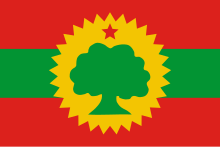Oromia Region
Oromia (in Oromo, Oromiya or Oromiyaa) is one of the ten ethnic divisions or regions (or Kililoch) from Ethiopia. With an area of 286,612 km², it is the largest in the country. It has an estimated population of 35 million inhabitants, constituting the most populated region of Ethiopia. It is populated, mostly by the Oromo ethnic group (formerly called galla or gal'la). Its capital is the city of Adama.
History
Oromia was annexed at the end of the 19th century to Ethiopia. In 1918, the Oromo prince, Lij Yasu (Michael), son of the king of Wolo (Oromía) Mohammed Ali, came to the throne but when he was overthrown by Haile Selassie the kingdom of Wolo declared itself independent. In 1935, with the Italian invasion ad portas, the Oromo claimed to be recognized as a state. In 1936, the Oromo fought against the Italians and ceased their war against Ethiopia. In 1941 they again claimed to be recognized as an independent state. In the same year, Oromo resumed their war against Hailes Selassie, but with the help of British aircraft they were quickly defeated.
In 1963, the rebellion led by Waqo Gutu (Bale's revolt) began, which spread through the three Oroma provinces; which was not controlled until 1972. In 1964 a pan-oroma organization was created, the MatchaTulama Association (1964-1967) directed by General Tadesse Birru. In 1967, said organization was banned. From the remnants of this organization and other nationalist groups, the Oromo Liberation Front (FLO) emerged in 1973.
In 1975, the Dergue—the Marxist military government—promised self-determination to the various peoples of Ethiopia. For a time it gained some support, but it soon became apparent that it was an amhara domination. Several nationalist groups participated in the fight against the military junta, including the FPLT, which requested joint action from the FLO. As he refused, the FPLT organized a new liberation movement with the prisoners of war of this ethnic group: the Democratic Organization of the Oromo People (ODPO) of Marxist tendency. Simultaneously they also created an opposition group that actually claimed to represent the Amhara: the Revolutionary Movement of Ethiopian Democratic Officers (MRODE).
In 1981 a group from the Ethiopian People's Revolutionary Party (PRPE) had surrendered to the PFLT and with them another Amhara organization was organized: the Ethiopian People's Democratic Movement (MDPE). With these groups the Revolutionary Democratic Front of the Ethiopian People (FDRPE) was formed. In 1992, the FLO announced that it would not participate in the elections and that it was withdrawing from the transitional government of which it was one of the three founders. The Southern Ethiopian Peoples' Democratic Coalition (10 parties) rejected the election results that gave hegemony to the PFLT and its regional satellite organizations.
Geography
Oromia covers about 286,612 square kilometers and includes the former province of Arsi together with parts of the former provinces of Bale, Hararghe, Illubabor, Kaffa, Shewa and Sidamo. The peoples of the region include Adama, Ambo, Asella, Badessa, Bale Robe, Bedele, Bishoftu, Begi, Bule Hora, Chiro, Dembidolo, Fiche, Gimbi, Goba, Haramaya, Jimma, Metu, Nekemte, Sebeta, Shashamane and Waliso, among many others.
Administrative Subdivisions
The Oromia Region is divided into 12 administrative zones, each of which is subdivided into several woredas, or districts. In total, the region has 180 woredas.
- Arsi Zone (20 woredas):
- Zona Bale (17 woredas):
- Zona Borena (12 woredas):
- Illubabor Area (12 woredas):
- Yima Zone (13 woredas):
- West Hararghe Zone (10 woredas):
- East Hararghe Zone (15 woredas):
- West Shewa Area (23 woredas):
- East Shewa Area (12 woredas):
- North Shewa Area (12 woredas):
- Welega Occidental Zone (17 woredas):
- Welega Oriental Zone (17 woredas):
Demographics
According to the information of the 2007 Census provided by the Central Statistical Agency of Ethiopia, Oromia has a total population of 27,158,471 inhabitants, of which 13,676,159 are men and 13,482,312 women; Meanwhile, the urban population reaches 3,370,040 inhabitants, or 11.3% of the population. The region has a density of 76.93 people per km².
According to census figures, the region has 5,590,530 homes, being inhabited by an average of 4.8 people (3.8 people for urban housing and 5.0 people for rural housing). Regarding ethnic groups, it includes those belonging to the Oromo ethnic group (87.8%), Amhara ethnic group (7.22%), Gurage ethnic group (0.93% - including Sebat Bet Gurage, Soddo Gurage, and Silt&# 39;e); the remaining 4% are made up of other ethnic groups.
Of the total population, 47.5% is Muslim; 30.5% Coptic Christian; 17.7% Protestants; 3.3% followers of traditional religions; and the remaining 1.1% are made up of other religious groups. In urban areas, Orthodox Christians make up 51.2% of the population, followed by Muslims at 29.9%, Protestants at 17.5%, and other groups at the remaining 1.5%.
Political parties
The Oromo People's Democratic Organization (ODPO) party and the Oromo Liberation Unitary Front are part of the state government. The resistance includes the Oromia Liberation Front (OLF), the Islamic Front for the Liberation of Oromia (IFLO). In the opposition are the Oromo People's Liberation Organization (OPLO/IBSO) and the United Oromo People's Liberation Front (UOPLF).
In 1992 the government proposed to eliminate the OLF, which was considered inactive. But in 1994 the incidents began to be frequent. In 1995 the activity was extended to Bale, Hararge and Borana. The guerrillas in the area are considered entrenched, but lack sufficient foreign support.
The Islamic Front for the Liberation of Oromia began its armed activity in 1994 but since 1995 no new attacks were mentioned. It is supported by Saudi Arabia. A more recent Sudanese attempt to revive it fell through.
Contenido relacionado
Transportation in Bolivia
Gerhard Schröder
Menachem Begin



